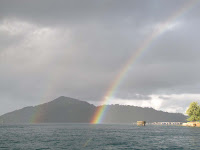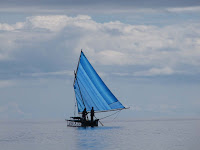We pulled out of our slip at 8:50 a.m. and waved goodbye to Hans and Gaby. The winds were light so we motored out of the harbor and through the pass in the reef; however, we didn't mind the calm conditions in which to exit this pass. We continued to motor until late afternoon when the winds picked up, and we could sail at about four knots.
Around six o'clock in the evening we were both in the cockpit when we heard a loud bang. We looked around to see what had happened and saw a Boobie who was out cold and lying on its back on our coach roof. We think that it flew right into the sail or the mast. Anyway, it became almost comical because it was on its back with its webbed feet sticking straight up in the air, and they were twitching. We knew that it was probably hurt, but the scene was just so funny. Finally, it sat up and looked around as if to say, "What happened-where am I?" It lay back down for a short time and then finally made it to its feet. Just as it was regaining its balance, a wave rolled the boat so it was knocked to the side deck. The poor thing was trying to walk around, but the deck was slippery from the water, and it was sliding all over the place. The next wave to hit the boat washed it over the side. We have no idea if it survived or not; however, it left a lasting impression on us because it regurgitated its last meal and pooped as well. It was too rough to go up and clean the deck so we just had to live with it.
We continued to sail throughout the second day until early evening when we approached Bramble Cay. Shortly after that we entered Bligh Passage, which meant that we were in the Torres Straits. The Torres Straits is the only way vessels can cross from the Indian Ocean to the Pacific Ocean without going south around Australia or north through the Philippines. The strait is intensely reef strewn, very shallow, and mostly unsurveyed because it is an extension of the Great Barrier Reef surrounding Australia. To facilitate shipping, a safe route approximately 150 miles long and 2 miles wide has been surveyed from the NE to the SW. You leave the Pacific Ocean at Bligh Entrance and exit into the Indian Ocean via Prince of Wales Channel. This passage is notorious for big short seas, high winds, and no place to find any protection. Additionally, there are many ships traveling in both directions, large trees adrift having flowed down the Fly River in PNG, and even fishing fleets trawling for mackerel. What was notorious for us is now confirmed as reality. We had 3 to 4 meter (10-15 feet or so) seas on a 3-second period (these are VERY short steep seas), and 30+ knots of wind. It was basically a white out. We took more water over the boat than we have taken in 7 years of sailing. What a scary night. We almost stopped at Coconut Island to get a break, but we decided to continue on, and we finally made it to Thursday Island. In talking with local professional mariners here in Thursday Island, they said that the strait is one of the most dangerous places to sail and that we managed to do OK in what were very bad conditions, even by their standards. We asked why they thought we did OK, and they said, "Because you made it, and we did not have to conduct a search and rescue (SAR)! " We were very reassured!
Our last bit of drama for this passage occurred about 30 minutes before we arrived. I was down below and Steve noticed that the boat was not steering at all. He looked back and saw that the water vane on our wind steering unit had broken in two and was just dragging in the water. Luckily, it had a safety line on it so Steve was able to retrieve it. If it had broken during the night, we are not sure how we could have stopped to fix it with the conditions that we had and continuing on would have meant hand steering in difficult conditions. We are so thankful that we did not have to deal with that situation.
We were very tired when we arrived on Monday afternoon; and, as usual, Steve had not slept at all. We contacted all the officials, had a slight run in with Quarantine but worked it out, ate a quick bite, and then CRASHED.
The next morning all the officials arrived in the Customs tender, and we were cleared into Australia without too much fuss. As the Customs officers leaving, they were nice enough to point out a very large "saltie" or crocodile on the beach. We unloaded the dinghy and went to shore to catch the ferry over to Thursday Island because we were actually anchored at Horn Island just two miles away. As we approached the dock, we saw that a local had hooked a 4- to 5-hammerhead shark. Welcome to northern Australia!
We ate lunch, provisioned with fresh vegetables, and filled out more Customs and Quarantine forms at their offices. It was nice to walk around for awhile after being on the boat for several days. We then returned to the boat to relax for the rest of the day.
Yesterday we prepared to leave, and Steve had to do a check of the propeller. He was in and out of the water very quickly as we did not want to tempt fate or the aquatic life in the area. Today we will leave for Darwin. The winds and tides look favorable for the passage that will take us about a week. We could stop along the way; however, we plan to do a straight run and stop only if necessary.
----------
radio email processed by SailMail
for information see: http://www.sailmail.com


.jpg)

.jpg)




.bmp)